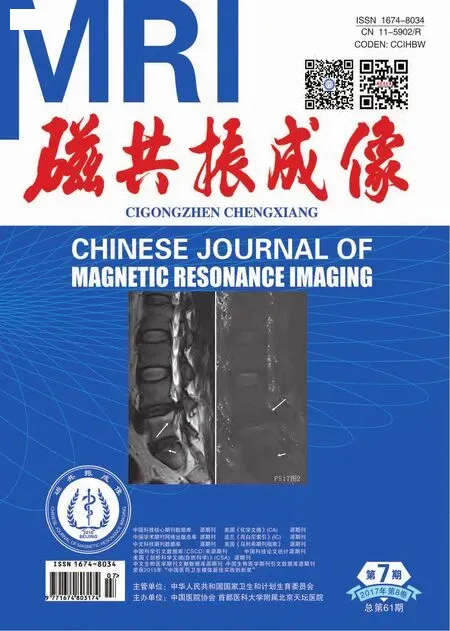CE-MRV顯示靜脈竇形態與眼壓關系的研究
梁英良,王嵩,姚曄
CE-MRV顯示靜脈竇形態與眼壓關系的研究
梁英良,王嵩,姚曄*
目的以增強磁共振靜脈造影(contrast-enhanced MR venography,CEMRV)為檢查方法,顯示靜脈竇的形態,明確橫竇形態的不對稱性與左、右眼之間的眼壓是否存在相關的聯系。材料與方法入組志愿者包括53名男性和52名女性自愿者。有過明顯神經疾患、眼病、靜脈血栓、青光眼排除在外。受檢者根據MRV掃描直竇的形態分為五組。組Ⅰ:L>>R左側明顯大于右側;組Ⅱ:L>R左側大于右側;組Ⅲ:L=R左側與右側相近;組Ⅳ:L<R左側小于右側;組Ⅴ:L<<R左側明顯小于右側。志愿者的眼壓在檢查前被分別測定。結果組Ⅰ、Ⅱ與組Ⅴ之間有統計學意義(P<0.05)。各組的眼內壓中,左、右眼均值之間,差異有統計學意義(P=0.04)。橫竇的不對稱性和右眼內壓值(r=0.51,P<0.01),呈負相關的關系;橫竇的不對稱性和左眼內壓值沒有統計學相關性(r=0.32,P=0.09)。結論左、右眼的眼壓與橫竇形態存在一定的聯系。右側的橫竇形態越粗,其引流的靜脈壓力較低,同側的眼壓也越低。
橫竇;高眼壓;低眼壓;磁共振成像
凡是不引起視功能和眼球組織損害的眼壓水平可以認為是正常眼壓,其正常范圍值為10~21 mm Hg,標準差為3 mm Hg[1]。正常人雙眼眼壓存在一定的差異,并且有時這種差異性較大[2]。如何解釋這種差異性?通過臨床的觀察,靜脈竇血栓的主要癥狀與靜脈回流受阻引起的顱高壓有關,表現為頭痛、嘔吐、視乳頭水腫、復視等[3];在一定意義上說明,靜脈竇的引流與眼部壓力及眼部靜脈引流存在一定的相關性[4]。在解剖學上,房水的產生與引流渠道都與眼部的靜脈相關,能否以這種不對稱性來解釋眼壓的差別,進而針對早期的眼壓增高及正常眼壓的變異進行甄別。筆者假設這種不對稱性可以用橫竇之間的解剖不對稱來解釋,即如果雙側橫竇之間存在著不對稱性可能導致雙側眼壓之間的不對稱。本研究以CEMRV為檢查手段顯示橫竇的形態并用以論證假設是否成立。
1 材料與方法
1.1 志愿者
本研究中共包括53名男性和52名女性志愿者,24~66歲。受試的志愿者中有過神經疾患、眼病、靜脈血栓、青光眼排除在外。受檢者根據MRV掃描橫竇形態分為五組,組Ⅰ:L>>R左側明顯大于右側;組Ⅱ:L>R左側大于右側;組Ⅲ:L=R左側與右側相近;組Ⅳ:L<R左側小于右側;組Ⅴ:L<<R左側明顯小于右側(圖1)。
1.2 測量標準
左、右側比值在0.8~1.2之間定義為組Ⅲ(L=R),左、右側比值>1.2 而<1.5定義為組Ⅱ,右、左側比值大于1.2而<1.5定義為組Ⅳ,左右側比值大于1.5以上定義為組Ⅰ,右左側比值大于1.5以上定義為組Ⅴ。
1.3 圖像采集
1.5T Simens Avanto掃描儀,掃描包括常規序列T1WI、T2WI、FLAIR、DWI及增強后3D-T1WI序列。掃描參數,T1WI:FOV 28 cm×28 cm,TR 550 ms,TE 10 ms,ETL為3,矩陣256×192;T2WI:FOV 28 cm×28 cm,TR 6000 ms,TE 104 ms,ETL為24,矩陣288×190;FLAIR:TR 2680 ms,TE 60 ms,IR 2000,矩陣256×192;DWI:FOV 28 cm×28 cm,TR 5000 ms,TE 60 ms,矩陣128×96,30 s;3D-T1WI:TR 550 ms,TE 10 ms,反轉角25°;FOV 24 cm×24 cm,slice=180,體素0.8 mm×0.8 mm×0.8 mm。掃描結束后以MIP重建模式后處理,層厚為25 mm。
1.4 眼壓的測定
專用眼壓儀(TOPCON CT80A)測定眼內壓,共測量三次取三次的平均值。測定的眼壓值與MRV分型結果分離雙盲分析。
1.5 統計學分析
使用SAS v8.12 統計分析軟件,對各組之內的左眼和右眼的眼壓值及左、右眼壓之間進行配對樣本的t檢驗,組間的比較采用單因素方差分析。對橫竇形態的不對稱性(左右比值)和兩眼的眼壓值分別進行Pearson相關分析,P<0.05認為存在統計學意義。
2 結果
根據MRV所示靜脈竇形態分組情況和各組所測得橫竇的數值見表1 (圖1)。
表2所示的是在不同組間的平均眼內壓值,平均值為15 mm Hg,區間為12~20 mm Hg。各組志愿者的眼內壓均在正常值內。各組的眼內壓中,左、右眼均值之間,差異具有統計學意義(P=0.04)。組間的比較:組Ⅰ、組Ⅱ、組Ⅴ之間存在統計學意義(組Ⅰ、Ⅱ比較:F=7.17,P<0.01;組Ⅰ、Ⅴ比較:F=8.11,P<0.01;組Ⅱ、Ⅴ比較:F=5.29,P<0.01)。

表1 根據MRV所示靜脈竇形態分組和各組所測得橫竇結果(x±s)Tab. 1 According to the MRV shown in sinus morphology group and the measured results of each transverse sinus (x±s)

表2 不同組別左、右眼眼壓統計結果(mm Hg,x±s)Tab. 2 Intraocular pressure of left and right eyes in different groups (mm Hg, x±s)
橫竇的不對稱性的程度(左右橫竇測量的比值)和右眼內壓值呈負相關的關系(r=0.51,P<0.01);橫竇的不對稱性的程度和左眼內壓值沒有相關性(r=0.32,P=0.09)。

圖1 組Ⅰ~Ⅴ磁共振重建MIP圖像。A:組Ⅰ,L>>R左側明顯大于右側,左右比值大于1.5;B:組Ⅱ,L>R左側大于右側,左、右側比值>1.2 而<1.5;C:組Ⅲ,L=R左側與右側相近,左、右比值0.8~1.2;D:組Ⅳ,L<R左側小于右側,右、左側比值大于1.2而<1.5;E:組Ⅴ,L<<R左側明顯小于右側,右左比值大于1.5Fig. 1 Group Ⅰ—Ⅴ MRI of the MIP. A: Group Ⅰ, L>>R showed the left significantly larger than the right side. B: Group Ⅱ, L>R, left side is larger than right. C: Group Ⅲ, L=R, left and right is similar. D: Group Ⅳ, L<R, left side is smaller than the right. E: Group Ⅴ, L<<R the left significantly smaller than the right side.
3 討論
眼內壓主要決定因素是房水的產生與引流即房水動力學和眼部的生理功能周期[5-7]。眼部的睫狀體中睫狀突毛細血管的非色素上皮細胞分泌產生房水,進入后房后越過瞳孔到達前房,再從前房的小梁網進入Schlemm管,然后匯入鞏膜表面的睫狀前靜脈,回流到血循環[8]。眼部靜脈最大的特點在于沒有靜脈瓣,其引流的速度與壓力直接決定于匯入的大靜脈。眼部靜脈主要分深靜脈與淺靜脈,主要匯入海綿竇,而海綿竇向后經巖上竇與乙狀竇或橫竇相交通,經巖下竇與乙狀竇或頸內靜脈相交通[9]。筆者的假設也正是基于眼部靜脈的生理解剖學的特征,無靜脈瓣以及引流的方向。解剖學上一般右側橫竇大于左側者較多[10],與本研究結果(即右側橫竇占優勢者為總數的73/105)相符合。
Igarashi等[11]報道一例左側橫竇靜脈血栓的患者,其左側眼壓明顯增高(24 mm Hg),右側眼壓卻正常(17 mm Hg),間接地證實了本研究假設的合理性。
本研究中各組間左眼、右眼以及左右眼眼壓的差值存在統計學意義。另外雙側橫竇形態不對稱性與右側眼壓及雙側眼壓之間呈負相關的關系。但并未發現橫竇形態不對稱性與左側眼壓之間存在相關。從中我們可以看出橫竇不對稱與眼壓的關系,即右側橫竇越大,眼壓就越低。除了IV組外各組內左、右眼眼壓也存在統計學差異,這說明左、右眼之間也存在著不對稱性。而這種不對稱性可以用橫竇之間的不對稱來解釋,即如果雙側橫竇之間存在著不對稱性可能導致雙側眼壓之間的不對稱。Klysik等[12]曾經報道過右側平均眼壓低于左側,從本研究的結果來看,由于右側橫竇大于左側橫竇的變異存在較多數人群中,眼壓的差異性有可能是其中較為重要的因素之一。
眼壓高于統計學上限,但缺乏可檢測出的視盤和視野損害的臨床指標及癥狀,臨床上統稱為高眼壓或可疑青光眼。在40歲以上的人群中,約有7%的個體眼壓超過21 mm Hg,大多數高眼壓癥經長期隨訪觀察,并不出現視盤和視野損害,其中僅有大約10%的個體可能發展為青光眼,而且大多數發生在左眼[13]。本研究以3D-T1WI結合最大強度投影(maximum intensity projection,MIP)顯示的方法,為其合理的解釋提供了一種可行的檢查手段。在MR成像技術中,時間飛躍法(time-of-flight,TOF)和相位對比法的血管成像也具有無創、無對比劑等優點,也曾經是熱點研究的內容之一[14],但它的檢查耗時長,需要患者的配合,易受血流形式和方向的影響而產生偽影,不能大范圍顯示靶血管。在本研究中為了獲得良好的圖像,采用了3D-T1WI掃描序列,掃描體素達到0.8 mm×0.8 mm×0.8 mm,同時本研究中采用了適中層厚的MIP重建,保證顯示靜脈竇的完整性。TOF技術對復雜血流顯示能力較差,與TOF相比CEMRV顯示靜脈更加準確,但也存在缺點,因為其需要注射對比劑增加了檢查費用,但在顯示靜脈竇的準確性方面較TOF提高,尤其在定量測量方面存在一定優勢[15],所以本研究中采用CE-MRV的方法。對比劑增強的螺旋CT靜脈血管成像(CT venography,CTV)和3D CE-MRV均屬無創性檢查,總體上相類似,但也存在不足之處[16]:(1)CTV不可避免產生離子輻射損傷;(2) CT上的骨骼、鈣化灶或其它高密度灶的結構均會重疊遮蓋血管,妨礙血管的顯示;(3) MR檢查采用的造影劑比CTV采用的碘對比劑安全的多,同時過敏反應要少的多。本研究的不足之處主要是沒有研究早期眼壓增高患者的左右靜脈竇情況,在病理情況下尤其在早期眼壓增高的疾病條件下的比較更具有臨床意義。
本研究得出初步的結論,如果右側橫竇較粗大,其相應引流的眼靜脈壓力較低,眼壓也相對較低。人群中正常眼壓差值變異與橫竇的形態可能存在一定的相關性;增強后CE-MRV檢查可以作為檢查手段顯示橫竇的形態,進而合理地證實本研究的結論。
[References]
[1] Cheng J, Kong X, Xiao M, et al. Twenty-four-hour pattern of intraocular pressure in untreated patients with primary open-angle glaucoma. Acta Ophthalmol, 2016, 94(6): e460-467.
[2] Abeg?o PL, Willekens K, Van Keer K, et al. Ocular blood flow in glaucoma-the leuven eye study acta ophthalmol. 2016, 94(6): 592-598.
[3] Tan JJ, Hassoun A, Elmalem VI. Cerebral venous sinus thrombosis with ophthalmic manifestations in 18-year-olds on oral contraceptives. Clin Pediatr (Phila), 2014, 53(9): 826-830.
[4] Herweh C, Griebe M, Geisbüsch C, et al. Frequency and temporal profile of recanalization after cerebral vein and sinus thrombosis. Eur J Neurol, 2016, 23(4): 681-687.
[5] Kiel JW, Hollingsworth M, Rao R, et al. Ciliary blood flow and aqueous humor production. Prog Retin Eye Res, 2011, 30(1): 1-17.
[6] Gulati V, Ghate DA, Camras CB, et al. Correlations between parameters of aqueous humor dynamics and the influence of central corneal thickness. Invest Ophthalmol Vis Sci, 2011, 52(2): 920-926.
[7] Zouache MA, Eames I, Samsudin A. Allometry and scaling of the intraocular pressure and aqueous humour flow rate in vertebrate eyes.PLoS One, 2016, 11(3): e0151490.
[8] Ma?lanka T. Autonomic drugs in the treatment of canine and feline glaucoma. Part II: Medications that lower intraocular pressure by reducing aqueous humour production. Pol J Vet Sci, 2014, 17(4):753-763.
[9] Ogle OE, Weinstock RJ, Friedman E. Surgical anatomy of the nasal cavity and paranasal sinuses. Oral Maxillofac Surg Clin North Am,2012, 24(2): 155-166.
[10] Mogicato G, Raharison F, Ravakarivelo M, et al. Normal nasal cavity and paranasal sinuses in brown lemurs eulemur fulvus: computed tomography and cross-sectional anatomy. J Med Primatol, 2012,41(4): 256-265.
[11] Igarashi H, Igarashi S, Fujio N, et al. Magnetic resonance imaging in the early diagnosis of cavernous sinus thrombosis. Ophthalmologica,1995, 209(5): 292-296.
[12] Klysik A, Kaszuba-Bartkowiak K, Jurowski P. Axial length of the eyeball is important in secondary dislocation of the intraocular lens,capsular bag, and capsular tension ring complex. J Ophthalmol,2016, 2016: 6431438.
[13] Gao Z, Guo H, Chen W. Initial tension of the human extraocular muscles in the primary eye position. J Theor Biol, 2014, 353: 78-83.
[14] Zhang YQ, Li J, Xu L, et al. Anterior visual pathway assessment by magnetic resonance imaging in normal-pressure glaucoma. Acta Ophthalmol, 2012, 90(4): e295-302.
[15] Ho LC, Conner IP, Do CW, et al. In vivo assessment of aqueous humor dynamics upon chronic ocular hypertension and hypotensive drug treatment using gadolinium-enhanced MRI. Invest Ophthalmol Vis Sci, 2014, 55(6): 3747-3757.
[16] Vaid S, Vaid N. Normal anatomy and anatomic variants of the paranasal sinuses on computed tomography. Neuroimaging Clin N Am, 2015, 25(4): 527-548.
The study of relation between size of transverse sinus by MRV and pressure of eyes
LIANG Ying-liang, WANG Song, YAO Ye*
Department of Radioligy, Shanghai Longhua Hospital, Shanghai University of Traditional Chinese Medicine, Shanghai 200032, China
*
ACKNOWLEDGMENTSScientific Research Project of Shanghai Municipal Commission of Health and Family Planning (No. 201540198).
Objective:The purpose of this study was to investigate possible relationships between the asymmetry of transverse sinuses in CE-MRV and intraocular pressures of right and left eyes.Materials and Methods:In this study, subjects were 53 male and 52 female volunteers. Subjects with neurological and ophthalmologic disease,particularly dural sinus thrombosis, myopia, trauma and glaucoma, were excluded in the study. Subjects were divided into five groups according to the magnitudes of the rightand left-transverse sinuses in MR venography results. Group Ⅰ: L>>R. L significantly greater than R. Group Ⅱ: L>R, L greater than R. Group Ⅲ: L=R, the left and right sides are basically similar. Group Ⅳ: L<R, L smaller than R. Group Ⅴ: L<<R, L significantly smaller than R. The pressure of the eyes was been measured respectively.Results:The difference between percentages of subjects in group Ⅰ, Ⅱ and Ⅴ was statistically significant (P<0.05). The differences in the mean intraocular pressures of right and left eyes were statistically significant (P=0.04). There were inversePearsoncorrelations between asymmetry index of transverse sinus and intraocular pressure of the right eye(r=0.51,P<0.01), but was not significant correlation between asymmetry index of transverse sinus and intraocular pressure of left eye (r=0.32,P=0.09).Conclusions:There is a relation between intraocular pressures of the right and left eyes and asymmetry of the transverse sinus. If the right transverse sinus on one side is larger and its venous drainage is greater, the intraocular pressure of the eye on this side is lower.
Transverse sinuses; Ocular hypertension; Ocular hypotension; Magnetic resonance imaging
Yao Y, E-mail: 122186836@qq.com
Received 8 Feb 2017, Accepted 6 June 2017
上海市衛生和計劃生育委員會科研課題(編號:201540198)
上海中醫藥大學附屬龍華醫院,上海200032
姚曄,E-mail:122186836@qq.com
2017-02-08
接受日期:2017-06-06
R445.2;R770.4
A
10.12015/issn.1674-8034.2017.07.005
梁英良, 王嵩, 姚曄. CE-MRV顯示靜脈竇形態與眼壓關系的研究. 磁共振成像, 2017, 8(7): 505-508.< class="emphasis_italic">Correspondence to: Yao Y, E-mail: 122186836@qq.com

